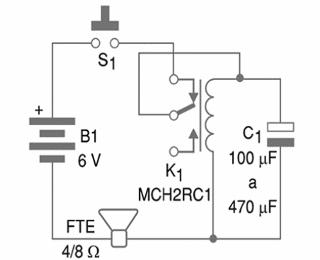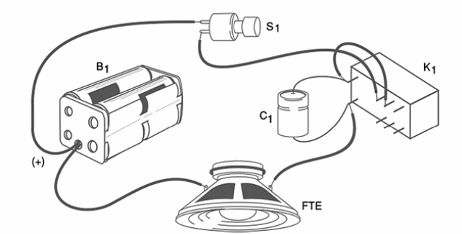This simple circuit imitates the sound of a machine gun and, when using a larger capacitor, a motorcycle. The circuit is very simple and some of the used components can be found in old appliances. The circuit can be used in special effects, toys, robots, etc.
Note: this project is part of my book Scence Fair and Technology Education Projects published in USA.
The circuit works as it follows: pressing S1, the capacitor charges, but it does not immediately open its contacts, recovering its initial position. It takes some time to allow the capacitor to discharge across the coil of the relay. When the contacts return to the initial position, the relays close again and a new cycle of operation begins.
So, the relays close and open the contacts fast, with the currents crossing the loudspeaker, reproducing a sound like a machine gun. Depending on the used relay, the reader must find the best value of the capacitor for the desired effect. Figure 1 shows the simple diagram of the Machine Gun.

Figure 2 shows how the components are interconnected. The complete circuit can be housed inside a small plastic box.

Any relay with a 6 V coil and turn-on current up to 100 mA can be used. Economic types are recommended. The capacitor has a value between 100 ?F and 470 ?F, with voltages starting on 12 V.
S1 is a push button and the power supply is formed by 4 AA cells. Any loudspeaker from 2.5 cm to 10 cm and impedances in the range between 4 and 8 Ω can be used. To test the circuit, press S1. Change C1 if the sound is not the one expected.
B1—6 V—4 AA cells with holder
S1—Push button
K1—Any 6 V x 100 mA relay with SPDT
C1—100 µF to 470 µF x 12 V or more—electrolytic capacitor
FTE—2.5 to 10 cm—4 to 8 ohm—loudspeaker
Other:
Plastic box, wires, solder, etc.



